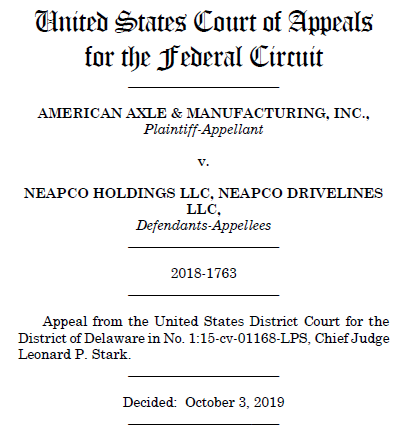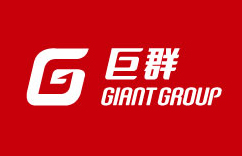【智財評析】機械案件之專利「適格性」(eligibility)要件判斷:美國聯邦巡迴上訴法院American Axle & Manufacturing v. Neapco Holdings案評析
2019-12-25 陳志清 律師/專利師 (資格)
機械案件之專利「適格性」(eligibility)要件判斷:美國聯邦巡迴上訴法院American Axle & Manufacturing v. Neapco Holdings案評析


【重要美國專利案例評析】
美國聯邦巡迴上訴法院於2019年10月3日由法官以2:1的結果,依據多數意見做出了重要的American Axle & Manufacturing, Inc. v. Neapco Holdings LLC 案判決[附註1],其係關於機械技術相關專利申請案之專利「適格性」(eligibility)要件判斷,並據此認為系爭專利因為不符合美國專利法第101條之專利「適格性」要件,而導致專利無效。由於專利「適格性」要件的判斷問題已經進入機械相關領域了,因此,非常值得讀者注意!
案件背景事實
1. 本案的原告為專利權人「美國軸及製造公司」American Axle & Manufacturing, Inc.(以下簡稱為”AAM”);而本案的被告為被控侵權人Neapco Holdings LLC、以及Neapco Drivelines LLC(以下合稱為”Neapco”)。
2. 本案原告AAM的系爭專利為美國專利號碼第US 7,774,911號(以下簡稱為” ’911專利”),其代表性申請專利範圍為第1項以及第22項[附註2]:內容係關於一種軸組件的製造方法,其關鍵在於設置了一個經過調整後的「襯墊」(liner),而可用來同時降低「殼模態」(shell mode)、以及「彎曲模態」(bending mode)的兩種震動模態。但問題是,於該申請專利範圍內並沒有對該「襯墊」應該如何來調整才能達到該目的做出任何描述。
1. A method for manufacturing a shaft assembly of a driveline system, the driveline system further including a first driveline component and a second driveline component, the shaft assembly being adapted to transmit torque between the first driveline component and the second driveline component, the method comprising:
providing a hollow shaft member;
tuning at least one liner to attenuate at least two types of vibration transmitted through the shaft member; and
positioning the at least one liner within the shaft member such that the at least one liner is configured to damp shell mode vibrations in the shaft member by an amount that is greater than or equal to about 2%, and the at least one liner is also configured to damp bending mode vibrations in the shaft member, the at least one liner being tuned to within about ±20% of a bending mode natural frequency of the shaft assembly as installed in the driveline system.
(其中,上述斜體字的用詞(tuning at least one liner to attenuate…)係於本系爭申請專利範圍中關於「適格性要件」的判斷爭議。)
3. 於2015年12月18日,原告AAM在聯邦德拉瓦州地方法院控告被告Neapco侵害其專利權,於審理過程中,法院將「調整」(tuning)這個用詞解釋為:”controlling the mass and stiffness of at least one liner to configure the liner to match the relevant frequency or frequencies”,兩造雙方對該解釋都沒有表達反對。之後,兩造雙方對於系爭專利是否符合美國專利法第101條之「專利適格性」要件皆提出「簡易判決動議」(cross-motions for summary judgment)聲請。於2018年2月27日,聯邦地方法院作出判決[附註3]認為:將系爭申請專利範圍整體觀之,其指向「自然法則」之概念-亦即「虎克定律」(Hooke’s law)、以及「摩擦阻尼」(friction damping)等,而所稱該些更進一步的步驟亦皆為相關科學社群中「已知的、常規的、或是習用的活動」(well-understood, routine, conventional activity),且將這些步驟整體觀之,與其個別元件加總起來並無遠遠地超過(nothing significant beyond)其結果,故同意被告Neapco的動議、拒絕原告AAM的動議,而認為系爭專利因為不符合「專利適格性」要件而無效。因此,原告AAM不服最後的判決結果,於2018年4月4日提起上訴,聯邦巡迴上訴法院稍後同意審理此案。
案件爭點
本案件的主要爭點即為:究竟本件與機械技術相關的系爭專利是否符合美國專利法第101條之「專利適格性」要件?
相關法律規定
1. 美國專利法第101條所定義的「專利適格性之標的」(subject matter eligible),包含有以下四種標的-方法(process)、機器(machine)、製品(manufacture)、組合物(composition of matter),或再加上其改良(improvement),原文如下:
35 U.S. Code § 101. Inventions patentable
“Whoever invents or discovers any new and useful process, machine, manufacture, or composition of matter, or any new and useful improvement thereof, may obtain a patent therefor, subject to the conditions and requirements of this title.”
2. 而美國專利法的「法定專利適格標的之例外」(judicially recognized exceptions),並不是規定於法條中,而是由法院以判決所創設的,其中包含有:「自然法則」(laws of nature)、「自然現象」(natural phenomena)、以及「抽象概念」(abstract idea)此三種不予專利之標的。然而,有時會藉由上述此三種工具「自然法則」、「自然現象」、及「抽象概念」來達成一發明,因此,不可因為一件發明僅僅涉及了「抽象概念」就讓其不具專利適格性。也就是還需要再進一步判斷的意思。
[T]he Supreme Court has long recognized that § 101 “contains an important implicit exception: Laws of nature, natural phenomena, and ab-stract ideas are not patentable.” Ass’n for Molecular Pa-thology v. Myriad Genetics, Inc., 569 U. S. 576, 589 (2013) (brackets omitted) (quoting Mayo, 566 U. S. at 70).
3. 美國聯邦最高法院於2012年的Mayo案判決、以及2014年的Alice案判決中,已經建立了所謂的「Alice/Mayo兩步測試法」(Alice/Mayo two-part test),用以區別一發明究竟是為「自然法則」、「自然現象」、及「抽象概念」、或是其為具有專利適格性之發明。其中,第一步需先決定系爭申請專利範圍的內容是否會「指向」(directed to)三種不具專利「適格性」概念中之一種?若是的話,第二步則要搜尋看看是否有「發明構想」(inventive concept)?亦即,必須判斷系爭申請專利範圍中之個別元件、以及由整體觀之,其組合是否具有更多的元件可將其發明之本質「轉換」(transform)為一具有專利適格性之發明,或是說該元件或其組合足以使該發明可「遠遠地超過」(significantly more)於該不具專利適格性之概念本身?當然,若是可以構成的話,就會被判斷為具有專利適格性。[附註4]
At step one of the Mayo/Alice test, we ask whether the claims are directed to a law of nature, natural phenomenon, or abstract idea. Alice, 573 U. S. at 217 (citing Mayo, 566 U. S. at 77). If the claims are so directed, we then ask whether the claims embody some “inventive concept” — i.e., whether the claims contain “an element or combination of elements that is ‘sufficient to ensure that the patent in practice amounts to significantly more than a patent upon the ineligible concept itself.’” Id. at 217–18 (brackets omitted) (quoting Mayo, 566 U. S. at 72–73).
4. 由於在不同意見書中提到本案的判決很可能會跟美國專利法第112(a)條中所規定的「可據以實施要件」(enabling requirement)有所混淆,故在此一併列出給讀者作為參考。
35 U.S. Code § 112. Specification
(a) In General. —
The specification shall contain a written description of the invention, and of the manner and process of making and using it, in such full, clear, concise, and exact terms as to enable any person skilled in the art to which it pertains, or with which it is most nearly connected, to make and use the same, and shall set forth the best mode contemplated by the inventor or joint inventor of carrying out the invention.
聯邦巡迴上訴法院見解
1. 聯邦巡迴上訴法院維持了聯邦地方法院之決定,其多數見解之結果認為:系爭專利僅僅是「自然法則」概念之發明,因此,並不符合「專利適格性」要件而導致系爭專利無效。
2. 聯邦巡迴上訴法院所採取的理由與見解如下:
(1) 在「Alice/Mayo兩步測試法」的第一步驟,系爭申請專利範圍中僅僅陳述可藉由調整「襯墊」以達到減震效果而已,但問題是申請專利範圍中並未指導如何達成此運用「自然法則」,這就是先前Mayo案所要求應避免的僅僅是說「運用」二個字而已。而原告AAM所反駁可以達到該效果的機制並沒有實際地寫在系爭申請專利範圍內。
[The claims] simply state that the liner should be tuned to dampen certain vibrations. Thus, the problem is that the claims’ instruction to tune a liner essentially amounts to the sort of directive prohibited by the Supreme Court in Mayo — i.e. “simply stat[ing] a law of nature while adding the words ‘apply it.’” 566 U. S. at 72.
[…]
The elements of the method here that AAM argues take the patent outside the realm of ineligible subject matter — i.e. the mechanisms for achieving the desired result — are not actually claimed in claim 1 or claim 22 of the patent.
American Axle & Manufacturing, Inc. v. Neapco Holdings LLC, No. 2018-1763, slip op. at 11-14 (Fed. Cir. 2019).
(2) 原告AAM或許已經發現一些方法可以來達到所述的效果,但是卻沒有把它們寫進申請專利範圍內,若把這些方法,例如是運用「有限元素分析法」(finite element analysis,簡稱FEA)寫入申請專利範圍內,或許本案的結果會有所不同。但系爭申請專利範圍卻只是教導應該要運用這些「自然法則」,再搭配一些「試誤程序」(trial-and-error process)來達成該效果而已。
This case might well be significantly different, if, for example, specific FEA models were included in the claims. But, the claims’ general instruction to tune a liner amounts to no more than a directive to use one’s knowledge of Hooke’s law, and possibly other natural laws, to engage in an ad hoc trial-and-error process of changing the characteristics of a liner until a desired result is achieved.
American Axle & Manufacturing, Inc. v. Neapco Holdings LLC, No. 2018-1763, slip op. at 15 (Fed. Cir. 2019).
(3) 要判斷是否符合「專利適格性」分析的第一步驟,對於結果與手段的區分是基礎的(This distinction between results and means is fundamental to the step 1 eligibility analysis, including in law-of-nature cases, not just abstract-idea cases. See Diamond v. Diehr, 450 U. S. 175, 191 (1981).)。因此,藉由同樣是分析是否是運用「自然法則」的聯邦最高法院之Parker v. Flook案[附註5]來作為參考。本案就像Flook案一樣係使用「自然法則」,Flook案並未揭露如何地量測得相關參數、也並未揭露該警示系統如何地運作以達到其功能效果的手段;而系爭申請專利範圍內並沒有揭露如何地決定目標頻率、以及如何地藉此來調整「襯墊」以同時減低兩種的震動模態之效果。
系爭申請專利範圍僅僅是指示讀者在一個複雜的系統中運用「虎克定律」[附註6](當固體材料受力後,應力與應變(單位變形量)成線性關係;這是一個所有學機械的人都知道的「自然法則」),來調整「襯墊」以達到減震效果而已,並沒有指示出要「如何做」才能達到這個效果。
The claims here simply instruct the reader to tune the liner — a process that, as explained above, merely amounts to an application of a natural law (Hooke’s law) to a complex system without the benefit of instructions on how to do so.
American Axle & Manufacturing, Inc. v. Neapco Holdings LLC, No. 2018-1763, slip op. at 19 (Fed. Cir. 2019).
因此,系爭申請專利範圍僅僅是如何達成該結果的概念,而不論是什麼結構或是步驟可以達成(The focus of the claimed advance here is simply the concept of achieving that result, by whatever structures or steps happen to work.)。總之,聯邦巡迴上訴法院的想法是認為系爭申請專利範圍會指向「自然法則」概念本身。
(4) 而在「Alice/Mayo兩步測試法」的第二步驟,聯邦巡迴上訴法院認為,於系爭申請專利範圍中並沒有任何夠格可以稱為「發明構想」,足以將其「轉換」為一具有「專利適格性」之發明。因為,系爭申請專利範圍中宣稱所揭露的更多步驟,其實也是已知的、或是習用的。再者,其他步驟就像先前的Flook案一般,亦僅僅是不超過習用的「先解決方案」、及「後解決方案」之活動而已(amount to no more than conventional pre- and post-solution activity),皆無法導致該發明成為一具有「專利適格性」之發明。因此,結論:系爭申請專利範圍不符合「專利適格性」之要件!
3. 另外,由Moore法官所作出的不同意見書亦值得參考,其主要意見內容略為:多數意見中認為專利所揭露之內容是否可讓所屬相關技術領域之人士不需要「過度實驗」(undue experimentation)而可調整「襯墊」以達到減少震動模態的功能,恰巧就是美國專利法第112條的「可據以實施要件」所關心的。因此,專利權人未使其發明可據以實施,應該是讓系爭專利依據第112條無效、而非依據第101條。再者,若申請專利範圍已經可據以實施、但卻因為並未教導出「如何做」卻可以被認定為不符合「專利適格性」要件的話,這並非第101條之規定,而且就像希臘傳說中的九頭蛇妖又長出了另一個頭一般…。
另外,多數意見不應該將第112條的無效理由與第101條的無效理由混為一談,這是不同法條中的規定內容;又第112條中像是「過度實驗」是一個事實問題,不應被列入如第101條的法律問題中來做處理;多數意見雖然擔心結果導向的申請專利範圍,但Moore法官卻更擔心這種結果導向的司法判決結果…。
The majority acknowledges that there is a very specific example given in the patent with precise dimensions, weights, lengths, materials, positioning, etc. . . . Whether this disclosure combined with the knowledge of a skilled artisan would permit that skilled artisan to tune a liner to a given propshaft in order to reduce bending mode vibrations without undue experimentation is exactly and precisely the enablement test pursuant to § 112. A patentee's failure to enable his invention renders the claims invalid under § 112, it does not, however, render the claims ineligible under § 101. . . . To be clear, according to the majority, even if these claims are enabled, they are still ineligible because the claims themselves didn't teach how. This is now the law of § 101. The hydra has grown another head.
The majority holds that [the '911 claims] are directed to some unarticulated number of possible natural laws apparently smushed together and thus ineligible under § 101. The majority concludes that the inventive concepts "make no difference." Section 101 simply should not be this sweeping and this manipulatable. It should not be used to invalidate claims under standards identical to those clearly articulated in other statutory sections, but not argued by the parties. It should not subsume § 112. It should not convert traditional questions of fact (like undue experimentation) into legal ones. The majority's validity goulash is troubling and inconsistent with the patent statute and precedent. The majority worries about result-oriented claiming; I am worried about result-oriented judicial action.
American Axle & Manufacturing, Inc. v. Neapco Holdings LLC, No. 2018-1763, slip op. at 13-14 (Fed. Cir. 2019) (Moore dissenting).
小結
1. 本案件聯邦巡迴上訴法院作出決定,認為:機械技術相關之系爭申請專利範圍因為僅僅是「自然法則」概念之發明,並不符合「專利適格性」之要件,因而專利無效。這是繼之前「醫療診斷方法」Athena Diagnostics, Inc. v. Mayo Collaborative Services, LLC 一案的大混戰[附註7]之後,「專利適格性」又開啟了另一個可能性的戰場。故請讀者日後還需要再持續追縱聯邦巡迴上訴法院是否會同意進行「全院庭審」(en banc)來再聽證該案、或是若上訴到聯邦最高法院被准許審理後之最終判決結果為何。
2. 本案重要,因為專利「適格性」要件的判斷問題已經進入機械案件的相關領域了,因此,日後於申請專利範圍內只請求結果,除了原先需要考慮的要素有:(1) 專利說明書能否滿足「書面描述要件」(written description requirement)、(2) 專利說明書能否滿足「可據以實施要件」(enabling requirement)、以及(3) 美國專利法第112(f)條的「手段功能用語」(means plus function)之外,現在還需要多加入考慮「專利適格性」要件的問題了;而且很明顯地本案已經讓美國專利法第101條的「專利適格性」要件判斷的範圍變得更加寬廣、讓風險更高,相關內容值得從事美國專利實務者多加留意[附註8]。
3. 因此,於本American Axle & Manufacturing案之後,所有機械案件相關的專利申請案之撰寫、或是日後的修改、答辯等、甚至於多方復審程序、訴訟時的攻防等,都需要注意是否有可能會造成不符合「專利適格性」的要件,這點頗值得讀者注意!例如,有論者[附註9]指出於撰寫專利申請案時,就建議必須要於專利說明書與申請專利範圍內清楚地解釋「如何做」:係如何的運用「自然法則」、功能係如何達成的、以及結果係如何達到的;另外,「可據以實施要件」亦應加以注意。
本文章之專業內容,僅為提供資訊參考,非作為法律諮詢之用,亦純屬作者個人之意見,不代表本所或作者任何曾任職過單位之立場。
相關參考資料
1. 聯邦巡迴上訴法院:American Axle & Manufacturing, Inc. v. Neapco Holdings LLC, No. 2018-1763, __ F.3d __, 2019 WL 4865832 (Fed. Cir. October 3, 2019) (DYK, Moore (dissenting), Taranto) (D. Del.: Stark) 案判決原文,網址:http://www.cafc.uscourts.gov/sites/default/files/opinions-orders/18-1763.Opinion.10-3-2019.pdf(最後瀏覽日期:2019年12月4日)。
2. 系爭專利之另一代表性獨立項申請專利範圍為第22項:
22. A method for manufacturing a shaft assembly of a driveline system, the driveline system further including a first driveline component and a second driveline component, the shaft assembly being adapted to transmit torque between the first driveline component and the second driveline component, the method comprising:
providing a hollow shaft member;
tuning a mass and a stiffness of at least one liner; and
inserting the at least one liner into the shaft member;
wherein the at least one liner is a tuned resistive absorber for attenuating shell mode vibrations and wherein the at least one liner is a tuned reactive absorber for attenuating bending mode vibrations.
3. 聯邦地方法院:American Axle & Manufacturing, Inc. v. Neapco Holdings LLC (D. Del. 2018) Memorandum Opinion by District Judge Stark 案判決原文,網址:https://patentdocs.typepad.com/files/memorandum-opinion-4.pdf(最後瀏覽日期:2019年12月12日)。
4. 關於「專利適格性」要件之相關法律規定,請參考:陳志清著,「【智財評析】美國專利法中電腦實施發明之專利適格性的「兩步測試法」:美國聯邦最高法院Alice v. CLS Bank案評析」,巨群國際專利商標法律事務所,日期:2019年7月18日,網址:http://www.giant-group.com.tw/law-detail-742.html(最後瀏覽日期:2019年12月12日)。
5. Parker v. Flook, 437 U.S. 584, 98 S.Ct. 2522, 57 L.Ed.2d 451, 1978 U.S. LEXIS 122, 198 U.S.P.Q. (BNA) 193 (1978).
6. 「虎克定律」(Hooke’s law),請參考相關原理介紹,網址:https://zh.wikipedia.org/wiki/%E8%83%A1%E5%85%8B%E5%AE%9A%E5%BE%8B(最後瀏覽日期:2019年12月12日)。
7. 陳志清著,「【智財評析】「醫療診斷方法」專利適格性之大混戰:聯邦巡迴上訴法院駁回Athena v. Mayo案全院庭審聽證裁定之評析」,巨群國際專利商標法律事務所,日期:2019年9月25日,網址:http://www.giant-group.com.tw/law-detail-771.html(最後瀏覽日期:2019年12月12日)。
8. Gavin Liu著,「近期美國聯邦巡迴上訴法院專利判決整理 (1001-1015) - AMERICAN AXLE & MANUFACTURING v. NEAPCO HOLDINGS LLC [OPINION - PRECEDENTIAL] (2019-10-03)」,FairSky’s Patent Memo,日期:2019年12月1日,網址:https://fairsky-patent.blogspot.com/2019/12/1001-1015.html#more(最後瀏覽日期:2019年12月4日)。
9. Christopher Hall, “Practical Tips for Drafting Patent Applications After American Axle & Manufacturing Inc. v. Neapco Holdings,” IPWatchdog, 2019/10/31, 網址:https://www.ipwatchdog.com/2019/10/31/practical-tips-drafting-patent-applications-american-axle-manufacturing-inc-v-neapco-holdings/id=115470/(最後瀏覽日期:2019年12月4日)。
延伸閱讀:
消息來源:


